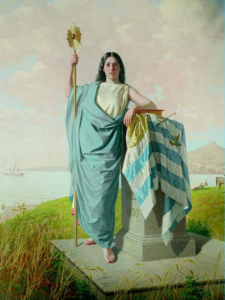
A personification of New Zealand on a postage stamp
Iconographically, the idea and image of the Motherland seems to have been more successful than that of the Fatherland. Most modern nations have symbolised themselves in the image of a woman. Female personifications of nations have a long genealogy going back to ancient Greek literary and artistic personifications of cities, lands, and countries. The tendency towards anthropomorphising, i.e., giving human form to concepts, cities, as well as deities, was characteristic of ancient Greek culture and influenced Roman religion, art, and everyday life. This usage survived into the post-Classical world, in Mediaeval Europe, flourishing during the Renaissance (e.g. Cesare Ripa’s Iconologia, 1593) and remaining a central iconographic device in Modern European art, while also spreading around the world through European expansion and/or imitation of European forms of expression.
In the ancient Greek world, one of the best known literary instances of personification are the embodiments of Hellas and Persia, appearing in Aischylos’ “Persai”, created in 472 B. C., and described as ideal female figures, distinguishable only thanks to their garments worn. Indeed, the Graeco-Persian wars served as turning point in the emergence of embodiments of countries, lands, territories, regions and cities as a distinct category of personifications1.

A personification of Urugay
In the 5th and 4th centuries BC, we thus see multiplication of works of art presenting cities in the form of a woman. Telephanes from Phokis, a sculptor who worked in the 5th c BC, during the early Classical period, in Thessaly and later on in Persia, made a bronze statue representing Larissa. A fragment of a copy of this work has been found in Persepolis. The city was depicted as a woman seated on a rock and leaning her head against her hand, as does the famous Penelope of Vatican2.
Although modern representations of nations place themselves in the ancient Greek and Roman tradition of personification of countries and cities, these personifications have distinctively modern iconographic and stylistic accretions. Several personifications of modern nations replicate the symbols of the French Revolution, and especially the Phrygian cap. Many also bear the national flag, and affirm the independence of their nation. They can also display the influence of more modern, abstract styles.
Female personifications of the nation also include robust women holding a sword, indicating the preparedness of women to defend their nation, as in Germania or Britannia. The city of Athens may have provided a visual precedent for this, as its emblem was the goddess Athena. Although not a personification, but rather an anthropomorphic conception of a deity, Athena appears in full armour. In addition, images of the revived concept of ‘la patrie’ around the time of the French Revolution, also show ‘La Patrie’ in female form fully armed.

A personification of Greece
Nevertheless, we can still classify personifications of nations, following Jocelyn Toynbee classification of ancient Greek and Roman personifications of countries and cities, by diving them into “idealistic”, wearing a classical Graeco-Roman costume and holding attributes, i.e., symbols and objects that characterise the national community or its territory, and the “realistic”, personifications, clad in national dress.
The choice of a woman to personify the nation is closely related to the idea of motherhood: the woman as the agent of life, generation and biological continuity of the nation. This is evident in, for example, images of mother India, Bharat Mata, through which the Indian nation imagined as mother/goddess, embodiment of the national territory, and unifying symbol for the country’s diverse communities. Soon after Mother India’s emergence in the late nineteenth century, artists, both famous and amateur, began to picture her in various media, incorporating the map of India into her visual persona. The images they produced enabled patriotic men and women in a heterogeneous population to collectively visualize India, affectively identify with it, and even become willing to surrender their lives for it (See, Sumathi Ramaswamy. The Goddess and the Nation, Duke University Press, 2010)’
1 – Janusz A. Ostrowski. Originalveröffentlichung in: Schmidt, Ernst Günther (Hrsg.), Griechenland und Rom. Vergleichende Untersuchungen zu Entwicklungstendenzen und -höhepunkten der antiken Geschichte, Kunst und Literatur, Tbilissi ; Erlangen ; Jena 1996, S. 264-272
2 – ibid.
-Athena Leoussi.
